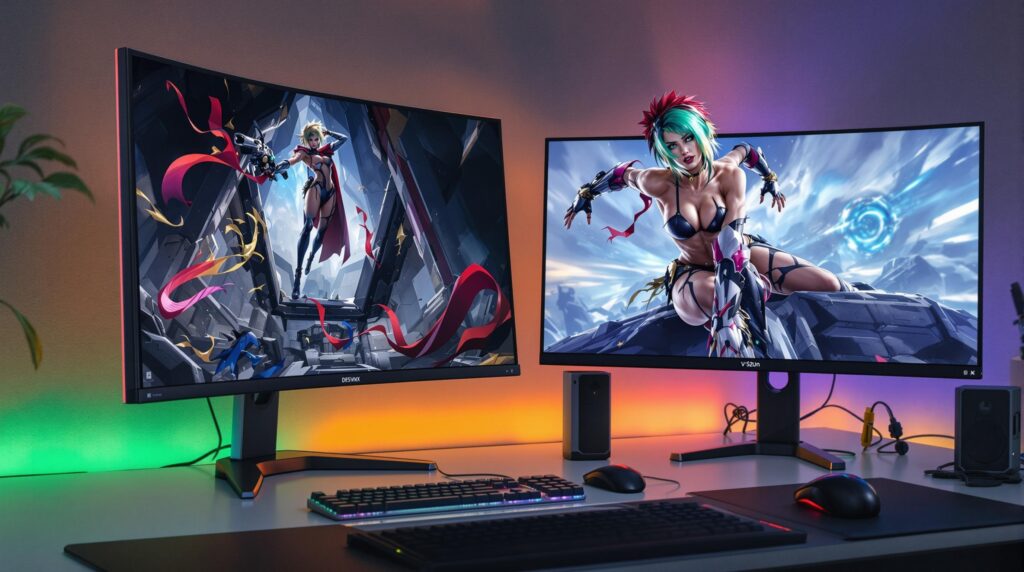Finding the best monitor for gaming in 2023 requires balancing cutting-edge features like high refresh rates and response times with panel technologies that deliver stunning visuals and smooth gameplay. The gaming display market has evolved dramatically, with OLED and Mini-LED technologies now setting new standards for contrast, color accuracy, and motion clarity that benefit both casual and competitive gamers.
Key Takeaways
- Modern gaming monitors now offer 240Hz refresh rates and response times as low as 0.03ms for competitive advantage
- QD-OLED technology provides superior contrast ratios (1,000,000:1) compared to traditional LCD panels
- Budget-friendly options starting at $159 still deliver essential gaming features like 144Hz+ refresh rates and adaptive sync
- Portable gaming monitors now reach 240Hz with HDR support, enabling high-performance gaming with smartphones and laptops
- Panel technology choice (OLED, VA, IPS) should match your gaming priorities and budget constraints
What to Look for in a Gaming Monitor in 2023
When shopping for a gaming display in 2023, several key specifications determine performance quality. For competitive gaming, a minimum 144Hz refresh rate is essential, while esports titles like CS2 and Valorant benefit from 240Hz or higher. Response time should be 1ms or less (GTG) to minimize ghosting effects during fast-paced action.
Panel technology significantly impacts your gaming experience. OLED delivers infinite contrast with perfect blacks, VA panels offer budget-friendly HDR capabilities with good contrast, and IPS provides superior color accuracy and viewing angles. For tear-free gaming, look for G-Sync Ultimate (NVIDIA) or FreeSync Premium Pro (AMD) certification.
HDR performance varies widely among gaming monitors. Entry-level models typically offer DisplayHDR 400 certification, but for truly impactful HDR gaming, DisplayHDR 1000 or higher provides the brightness needed for realistic highlights. If you’re struggling with display issues like white spots on your monitor, it’s worth addressing these before investing in a new display.

MSI MPG 321URX QD-OLED: The New Gaming Display King
The MSI MPG 321URX QD-OLED stands as the ultimate gaming monitor in 2023, combining a 32-inch 4K UHD panel with a blazing 240Hz refresh rate. Its QD-OLED technology delivers an astonishing 0.03ms response time, virtually eliminating motion blur in even the fastest-paced games.
Color performance is exceptional with 99% DCI-P3 coverage, while the 1,000,000:1 contrast ratio dwarfs traditional IPS panels (typically 1,000:1). This allows for stunning HDR visuals despite the relatively modest DisplayHDR 400 certification. The monitor supports both NVIDIA G-Sync and AMD FreeSync Premium Pro, making it versatile for all GPU users.
At $1,299, the MSI represents premium pricing, but delivers best-in-class performance for both competitive gaming and visually stunning single-player experiences.
Premium Alternatives: Samsung Odyssey Neo G8 and Gigabyte AORUS FO32U2 Pro
The Samsung Odyssey Neo G8 offers a compelling alternative with its Mini-LED backlight technology. This 32-inch 4K display matches the 240Hz refresh rate of the MSI but uses 1,196 dimming zones to achieve a 25,000:1 contrast ratio, significantly better than standard VA panels (3,000:1). With 2,000-nit peak brightness and a 1000R curvature, it excels in immersive single-player games.
Gigabyte’s AORUS FO32U2 Pro takes a different approach with a future-proof design featuring DisplayPort 2.1 support. This 32-inch 4K OLED also runs at 240Hz with a 1.5M:1 contrast ratio and 99% DCI-P3 coverage. Its 1,000 nits peak brightness delivers exceptional HDR performance.
Both alternatives offer excellent value. The Neo G8 is currently available at $800 (discounted from $1,400), while the AORUS costs $1,199.
Ultrawide Immersion: Samsung Odyssey OLED G9
For gamers seeking maximum immersion, the Samsung Odyssey OLED G9 presents a massive 49-inch super ultrawide display with 5120×1440 resolution and a cinematic 32:9 aspect ratio. The QD-OLED panel delivers 240Hz refresh rate with 0.03ms response time, combining size with speed.
The 1800R curvature enhances immersion in racing and flight simulators by wrapping the display around your field of view. This monitor effectively replaces dual 27-inch QHD displays, providing excellent multitasking capabilities for streamers or content creators who game.
At $2,499, the Odyssey OLED G9 commands a premium price but delivers an unmatched ultrawide gaming experience that transforms how games feel.
Best 1440p Gaming Monitors: Dell S3222DGM vs. LG UltraGear 27GP850-B
The Dell S3222DGM represents exceptional value for 1440p gaming with its 32-inch VA panel running at 165Hz. Its standout feature is the impressive 4,209:1 contrast ratio, delivering deep blacks and vibrant colors across 122% sRGB and 85% DCI-P3 gamut coverage.
At just $300, it’s half the price of many competitors while maintaining excellent gaming performance and visual quality. If you’re experiencing isolated white spots on your display, most can be addressed without replacing your monitor.
The LG UltraGear 27GP850-B takes a different approach with a 27-inch IPS panel that can be overclocked to 180Hz. With 98% DCI-P3 coverage, 400-nit brightness, and factory calibration, it’s ideal for users who need color accuracy alongside gaming performance. Its motion clarity rivals traditional TN panels while maintaining superior color reproduction.
Priced at $449, the LG commands a premium over the Dell but offers better colors and slightly higher refresh rates.
Budget-Friendly Options: AOC Q27G3XMN and NZXT Canvas 27F
The AOC Q27G3XMN delivers impressive specifications at a budget-friendly $349 price point. This 27-inch 1440p VA panel runs at 180Hz with a 3,000:1 contrast ratio and carries DisplayHDR 1000 certification. Its 8-zone local dimming improves HDR performance, making it one of the best value HDR gaming monitors available.
For esports enthusiasts on a tight budget, the NZXT Canvas 27F offers a 240Hz refresh rate with 1ms response time for just $159. This 27-inch 1080p IPS panel includes FreeSync Premium support, HDR400 certification, and VESA mount compatibility, covering all the essentials for competitive gaming.
Both monitors demonstrate that excellent gaming performance doesn’t necessarily require spending over $500, with the NZXT particularly standing out for high-framerate competitive gaming.
Portable Gaming: Premium vs. Budget Options
The Asus ROG Strix XG17AHPE sets the standard for premium portable gaming with its 17.3-inch 240Hz display. This 1080p IPS panel features a built-in 7,800mAh battery, 3ms response time, and HDR10 support, making it ideal for competitive gaming on the go. At $599, it represents the high end of portable gaming displays.
The Arzopa Z1FC offers remarkable value at just $179 with its 16.1-inch 144Hz panel. This 1080p portable monitor features USB-C and HDMI inputs, 300-nit brightness, and 8ms response time. It’s compatible with Samsung Dex, Huawei EMUI Desktop, and iPhone 15 (via adapter), making it versatile for mobile gaming across devices.
Both options cater to different segments of the portable gaming market, with the ROG for serious competitive players and the Arzopa offering excellent performance for casual mobile gamers.
Smartphone Gaming Monitor Integration
Modern smartphones can connect to gaming monitors through several methods. Wired connections typically use USB-C DisplayPort Alt Mode (available on devices like Samsung Galaxy S23 and iPhone 15) or HDMI adapters for older phones. Wireless alternatives like Miracast offer convenient connectivity for Android devices with under 50ms latency.
These connections unlock productivity benefits through desktop modes like Samsung Dex and Huawei EMUI, creating dual-purpose setups for work and play. For true mobility, look for portable monitors with USB-C power delivery and built-in batteries.
Response time becomes a consideration for competitive mobile gaming, as most portable displays are suitable for casual gaming but may present limitations for competitive play. Gaming with the whole family? Consider family-friendly gaming consoles that work well with these monitors.
Sources
rtings.com – Best Gaming Monitors
pcgamer.com – Best Gaming Monitor
tomshardware.com – Best Gaming Monitors
displayninja.com – Best Gaming Monitor



